by Ollie Sparks
The first day I started volunteering as a high school Sophomore, I journeyed deep into the heavy woods of the Rector area, into a small building just off a gravel road with a sign out front that read “Powdermill Avian Research Center.” The light was on in the small, cinder block banding lab, and I could see some people through my breath materializing in front of me. It was close to 5:30 in the morning, something I was unprepared for in the middle of summer vacation. That was the first of many surprises to follow that day.
As I accompanied the adults through net routes, watching them untangle birds caught in nets as easily as a practiced Rubix solver would twist a cube, I was amazed by the colors and sounds with each new bird. Some of these birds I recognized just from looking out my window: robins, blue jays, cardinals, and sparrows all made up the cast, but then came the birds I had never seen or heard of before, like an Ovenbird or a Northern Waterthrush.
Once we returned to the research station, the building where my day’s journey began, each of the cotton bags containing a bird were clipped to a pulley system by a multitude of colored carabiners, and one by one they emerged from their bags, held safely and securely in the bander’s grip. My job was to record the bird’s data; important marks like wing length, age, sex, weight, species, and band size all went into the program. Afterward, the banders sent the birds on their way by releasing them out of a nearby window. It was such a quick system, necessary because of how many birds the banding team would bring in each day.
Bird banding was not at all what I expected it to be, but there was something so enlightening about waking up, going to work like a responsible adult, and getting to spend my morning being in the wonderful outdoors. As a Boy Scout I had intermediate experience with campouts and tips for using the wilderness as a support for my life, so being immersed in it for extended periods of time while also getting to volunteer for important research really opened my eyes to a bigger world. I felt responsible for contributing, and respectful of my outdoor experiences.
Over the next few years, I continued volunteering at Powdermill Avian Research Center (PARC), finding new birds and recording new kinds of data. This focus on wildlife, the experiences, and sense of adventure nudged me slowly toward the best decision I had ever made in my time working at Powdermill: asking to provide my Eagle Scout Project, titled “(De)Forested Flight,” to PARC. (De)Forested Flight aimed to clear overgrown vegetation around the net routes and provide nesting sites for local breeding birds.

During the summer months, the vegetation around the mist nets grows quickly, and sometimes higher than the nets, which can decrease capture rate. The banding crew maintains the habitat in the banding area so that it is consistent year after year, but timing is important: major vegetation trimming needs to happen before the birds’ breeding season to avoid the risk of destroying nests. It’s a big job and the crew needs a lot of help, so I organized a day for my BSA Troop to go to PARC and help cut vegetation in coordinated areas.
For the most impactful part of my Eagle project, I researched what cavity-nesting species breed at Powdermill and assembled 22 bird boxes for five species: Wood Ducks, Eastern Bluebirds, Eastern Screech Owls, Black-capped Chickadees, and Tree Swallows, and enlisted the help of the Troop to help hang them in appropriate habitat.
On April 15, 2025, Powdermill Nature Reserve hosted an Eagle Scout Ceremony for the completion of (De)Forested Flight. I handed out special awards to all the amazing members who attended the Ceremony, followed by an emotional speech about the incredible mentors and role models who helped shape my journey as I advanced from Scout all the way up through Eagle, my wonderful family, and my own Troop 372 for their help and devotion to my Eagle Project. Earlier that same day, the banding crew spotted an Eastern Bluebird visiting one of the nest boxes I hung up the previous summer as part of my Eagle project.
As I look back on completing my Eagle Project, I’m reminded of how important it is to get out and keep trying new things. I was extremely grateful for all the welcoming and acceptance the staff at PARC gave me, and my Eagle Project felt like a fitting way of giving back to the community I had become a part of.
Ollie Sparks is a volunteer at Powdermill Avian Research Center and an Eagle Scout.
Read More Science Stories
A Year in Review: Bird Banding 2024
